"Why would anybody shoot at a police station?" |
Switchboard operator Julie after
the station comes under attack |
It's
a lie, of course, that title – every fan of the early films
of John Carpenter knows that. The assault in question is
not launched against Precinct 13, but Precinct 9, Division 13. But then this wasn't John Carpenter's
original title – the script, written under the same pseudonym
Carpenter used as editor on the final film, was titled 'The
Anderson Alamo'. It doesn't matter, not one jot. Where this happens is of little importance, but what happens and who it happens to most certainly
is. That it's downtown Los Angeles is not even an issue – Carpenter is not making a political statement, he is making
an urban Western. And it's a divine and beautiful thing.
So in this time of Hollywood creative vacuity, it's somewhat inevitable that some witless bastard would decide to
remake it and change the plot and characters just enough
to make you wonder why they didn't just break with the original and make their own damned movie. After all, Carpenter's version is essentially
an updating of two earlier classics, but one of the triumphs
of his film is that despite being ten percent Rio Bravo and ten percent Night of the Living Dead,
it's still eighty percent pure, undiluted Carpenter at his
most deliciously, seductively creative.
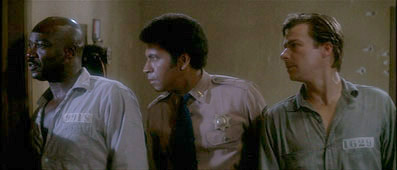
My
relationship with this film goes back a long way, right
back to film school in the late 1970s. Dark
Star was shown on TV over Christmas, but I
missed it because I was at the third night of Star
Wars. I'd heard about Assault and was utterly intrigued. In the time of the dark cynicism
of Taxi Driver and the political edge
of Blue Collar, here was a film that
critics were calling 'old fashioned' and not intending
it as as put-down, the sort of work about which people
were fond of saying, "They don't make 'em like
that any more," but one tinged with a very modern approach
to its violence. I first laid eyes on it at The Sherlock
Holmes Centre in London, the smallest cinema I have
ever been in, but by the end I couldn't have cared if
I had seen it on one of those little communication watches
from Thunderbirds – I was utterly,
completely bowled over. I ended up seeing the film over
thirty times at the cinema and writing my film school
dissertation on the first four films (three cinema,
one TV) from a director I believed had a glorious future ahead of him. Of course, every horror fan now knows the
name of John Carpenter and, like Clive Barker, he remains
a lucid and persuasive ambassador for the genre. He
may have fallen flat on his face a few times with the
likes of Village of the Damned and Ghosts of Mars, but he still has much
to be proud of: Halloween, The
Fog, The Thing and They
Live are all dynamite movies. But despite all
that has come since, my favourite John Carpenter film –
for a whole host of reasons – remains Assault
on Precinct 13.
The
plot begins as a number of seemingly disparate sub-stories unfold, all of which are destined to collide through a single random act
of violence:
a large consignment of weapons is hijacked by a multi-cultural
youth gang known as Street Thunder; young Kathy is being
driven across town by her father in an effort to persuade
her ageing grandmother to move out of the ghetto and
live with them; world-weary Detective Starker has landed the job
of transporting three prisoners to Death Row, including notorious
killer Napoleon Wilson; an ice-cream man
is touring the neighbourhood and selling his wares;
and on his first day in his new job, freshly promoted
lieutenant Ethan Bishop is sent to babysit a remote
police station that is in the final stages of being
moved to a new location. When one of Starker's prisoners is taken ill, the prison bus is forced to stop at the
very police station Bishop has just taken
temporary charge of, and the prisoners are placed in the holding cells
while Starker unsuccessfully attempts to call his superiors.
Meanwhile, the four warlords of Street Thunder swear
a blood oath and, armed to the teeth, cruise the neighbourhood
looking for someone to kill. Drawn to the jingle of the
ice cream truck, they initially threaten its driver,
then coldly murder Kathy when she innocently returns
to the van to query her purchase. Mortified and insane with grief and rage, her father
chases the gang and guns down the warlord who killed his daughter,
then finds himself pursued by an ever-growing army of gang members. He takes refuge in Bishop's police
station, by when he is in an uncommunicative state of
shock, and the occupants find themselves under
siege from the suicidally determined street gang.
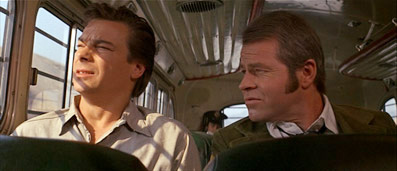
When
the opportunity to make his second film arose, Carpenter
was approached by backers with a tiny budget ($100,000)
and given complete freedom over his choice of project. He wanted dearly to make a western,
but with the popularity of the genre in nose-dive he
elected to take the themes and characters of the genre and update them to an urban gang setting. (Interestingly,
Katherine Bigelow was faced with the same dilemma a
few years later and turned her would-be western into
the vampire movie Near Dark.) Such
genre twisting can easily fall on its face, but
Carpenter makes it work divinely; by keeping his characters
and story development just one step away from reality,
he clues us in on to how to read the film from its earliest
stages. The multi-racial mix of the gang, their almost
complete lack of vocal communication and the cold viciousness
of their first kill all serve a specific purpose, to
mark them as the bad guys and give the audience little
opportunity to identify with them on a personal, cultural
or social level – these people are a collective
killing machine, and if they can kill that little girl
without even a flicker of reaction, then they can do
anything. This is binary opposition at work: there
are good guys and there are bad guys, and whatever their flaws may be, you always
root for the good guys. This
separational approach is especially important given
that one of the good guys is actually a mass murderer,
an aspect of his character that is neatly side-stepped
by making him witty, cynical and hugely likeable, while
his back story and motivation are effectively shrugged
off in a brief dialogue exchange with Starker on
the prison bus. He is also presented not as an aggressor
but a rebellious victim. His iconic introduction – a
rapid track/zoom to close-up – has him chained in a
cell, and while his captors are either physically abusive
or reading the rule book, Wilson makes a dry quip out
of just about everything. In the yard outside, when he trips the
warden up and delivers the second half of an amusing
two-part verbal gag, I had to fight the urge to cheer, and
I'd known him at this point for barely five minutes.
Street
Thunder, on the other hand, are presented from the off as a truly malevolent force. Carpenter's ace-in-the-hole here
is actor Frank Doubleday, who despite having not a word
of dialogue makes for a genuinely frightening gang Warlord (Doubleday memorably told Carpenter that he
did not want to play the character as a man who has
a gun, but a man who IS a gun). The scene in which he
terrorises the ice cream vendor by calmly inserting
a silenced gun into his mouth had me cringing with terror
on my first viewing and his almost indifferent shooting
of Kathy hits you like a bolt of lightning, in part
because it breaks the unspoken rule – in American movies
at least – that children can be menaced but should never killed. It's made all
the more disturbing by the news that Carpenter drew
the incident from real life: a street gang were hanging
around a bus stop and one of them said to the others:
"I'm going to shoot the next person that gets off
that bus"; a young girl got off and he shot her
and drove away. It's an idea that really scared
the young Carpenter, to be walking down the road and
be suddenly killed for no reason. The power and daring
of the scene could be measured on its initial release
by the occasional walkouts I witnessed at this point
in the film and in Carpenter's own conviction that he
would never be allowed to stage this sequence today.
Its importance in narrative terms is paramount: it catapults
the father into action and ultimately into the station
where most of the film's action will take place, but
its gravity renders him unable to communicate with his
helpers, leaving them in the dark over just why the building has come under attack. It also
tells us everything we need to know about the gang – they are ruthless, dangerous, and very, very bad.
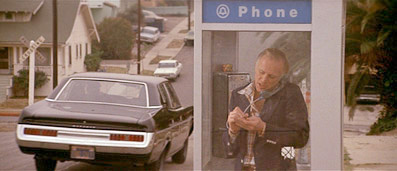
Having
introduced us to and aligned us with his main characters,
Carpenter then keeps them enclosed in the police
station for the remainder of the film, trapping us with them and creating an atmosphere of
increasing claustrophobia that can now be seen as almost
a dry run for The Thing. Remarkably,
there is no dramatic shift in tone once we are inside
the station – the balance between character detail,
tension and humour remains throughout and gives rise
to some extraordinary sequences that have you biting
your nails one second and laughing out loud the next.
A prime example of this comes during the initial attack
on the station, a semi-surrealistic scene in which
glass, wood and paper explode as bullets rain in from
a barrage of silenced weapons, which concludes with two small
pops that send sheets of paper comically airborne
like the contents of an indoor firework. It's an approach
that keeps us engaged with the characters and repeatedly
throws us off guard, with even the best moments of character
humour underpinned by the situational tension. This reaches a peak when
one of the group needs to be selected to sneak out and
hot-wire a nearby car – the sight of two hardened criminals
playing 'potatoes' to see who goes and who stays is
as bizarre an image for us as it is for their companions,
while the comedic banter that follows never dilutes the
very real fear you feel for the selected unfortunate.
As
their resources dwindle and their situation becomes desperate, Carpenter's grip as a thriller director tightens
all the more, and despite the narrative inevitability
of the finale it still manages to be seat-clenchingly
tense. Here the film stays true to its western roots, and
though Leigh emerges with strength and dignity, the
finale ultimately belongs to the men. Seemingly opposites
in the world of law and order, they are united by circumstance
and a common purpose that has given them deep respect
for each other – Bishop's angry "Get AWAY from him!"
to the cop who attempts to re-shackle Wilson never fails to
bring a lump to my throat.
Although
the western influence is key to the
film's unique style and feel, it is the
work of Howard Hawks, one of Carpenter's favourite directors,
that is most keenly felt. The plot itself is a reworking
of Hawks' 1959 Rio Bravo, in which
a rag-tag group consisting of a drunken sheriff, a seasoned
gunfighter, a young greenhorn and a spirited saloon
girl hold up in a jail that is besieged by outlaws
attempting to free their imprisoned boss (the recent
remake of Assault borrows more precisely
from this formula, which Hawks himself re-used in El
Dorado and Rio Lobo). Carpenter
has never pretended otherwise, of course, signaling
the connection with his editor credit as John T. Chance,
the character played by John Wayne in Hawks' original,
and by naming the female lead after that film's co-screenwriter,
Leigh Brackett. But an equal, more modern influence
was clearly George Romero's Night of the Living
Dead, which featured a small group holding
siege in a house against an army of attacking zombies
(here represented by the largely faceless and voiceless members of
Street Thunder), a young and resourcesful black leading man and a final
stand-off in the building's basement.
But if Street Thunder and Bishop are drawn from Romero, then
their companions are from Hawks and other Carpenter
favourite Sergio Leone, with Leigh every inch as tough and
cool as Angie Dickenson's Feathers in Rio Bravo ("You did good," Wilson tells her in true
Hawksian fashion) and Wilson as impenetrable and unemotional
as Charles Bronson's Harmonica in Once Upon
a Time in the West, a character who, like Wilson,
also promises to reveal key information about himself
only at the point of death. Rio Bravo (as well as Hawks' Red River) can also
be felt strongly in one of Assault's
most electrifying moments, where a shotgun is thrown and fired in the nick of time, and in the discovery of a body
through the dripping of their blood from aloft. Carpenter
completes the favourite director quadrilogy with a low
key nod to Hitchcock – the story Bishop tells Leigh
about his boyhood trip to the police station is Hitchcock's
own.
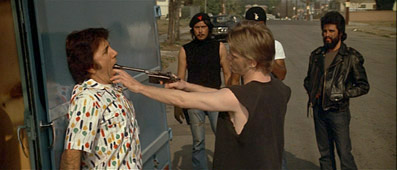
Despite
his young age and helming only his second feature,
Carpenter's confidence is writ large over every scene,
from the technical handling to his work with the actors.
Darwin Joston – an underused and now sadly missed actor
(he died of leukaemia in 1998) whose other key claim
to fame, apart from his cameo in Carpenter's The
Fog, is his small role as the button-pushing
Paul in David Lynch's Eraserhead – creates in Napoleon Wilson a hugely enjoyable anti-hero.
His laid-back growl is perfectly balanced by Austin Stoker's
energetically resourceful Bishop, whose youthful
enthusiasm and his wide-eyed disbelief at what is going
down eventually gives way to anger and excitable determination.
As Leigh, Laurie Zimmer (who appeared in only three
features before later becoming the subject of the 2003
French short film Do You Remember Laurie Zimmer?)
is both alluring and as tough as nails, the perfect
match in every way for Wilson, a Bacall and Bogart for
1970s urban Los Angeles. Completing the group is Tony
Burton (later to feature as Apollo Creed's trainer in
the Rocky films) as Wilson's agitated and determinedly
self-protective bus-mate Wells, the
inevitable weak link who discovers bravery and self-sacrifice,
but at a cost. Also making an impression as Starker and frightened receptionist Julie are Charles Cyphers and Nancy Loomis, both of whom landed more substantial roles in Halloween and The Fog, and it's worth noting that Carpenter cast Henry
Brandon as world weary desk sergeant Chaney in part
because he played the warrior Scar in John Ford's seminal The Searchers.
Carpenter's
camera placement is consistently impressive, as is Dark
Star cinematographer Douglas Knapp's moody
night lighting and use of the scope frame. He repeatedly
creates eye-catching shots that also have clear narrative purpose: the
Street Thunder car window that slowly rolls down to
reveal the barrel of an assault rifle and a huge silencer
conveys an extraordinary sense of the threat the gang
represent in a single image; the father seemingly trapped and isolated
in a phone booth as the gang car passes malevolently
in the other side of the frame; the poster shot of the
hesitant Wells emerging from the manhole as his companions
look nervously on; the scurrying figures that surround
the station, the screen width serving to exaggerate
their numbers; the smoke that clears to reveal three
figures desperately brandishing improvised weapons...
the list goes on. Despite (or perhaps because of) the
fact that this was his first experience with scope,
Carpenter all but ignores the once widely held
view that you cannot cut scope at the same pace as regular
widescreen or Academy ratios – indeed, the film was
featured in a BBC Moving Pictures article on
the cinemascope ratio as an example of a film that had
finally broken this rule, though in order to do so the
programme makers conveniently ignored Lou Lombardo's lightning
editing work on Peckinpah's 1969 The Wild Bunch.
The
final piece in the jigsaw is Carpenter's own, brilliantly
simple and effective score, a seductive blend of rhythmic clacking
and deep bass synthesiser that I still find myself humming
when driving through town (maybe that's not such a good
thing, given what it represents). Carpenter repeatedly
links the main theme to Street Thunder, sometimes announcing
their arrival in frame and departure from it, particularly
effective when the car is circling the ice-cream van
like a hungry black shark – when it disappears over
a hill and the music fades with it, we are given momentary
(and deceptive) reassurance that the vendor and his
young customer are safe from its bite. The music
has remained an iconic component of the film's effectiveness and identity
and in 1988 found a new audience when it was turned
into the top ten single Megablast by Bomb the
Base, which in turn became the soundtrack for the Bitmap
Brothers' hit Amiga game Xenon II. This recycling seems
only appropriate given that this very same main theme
was itself inspired by a combination of Led Zeppelin's The Immigrant Song and Lalo Schifrin's score
for Dirty Harry.
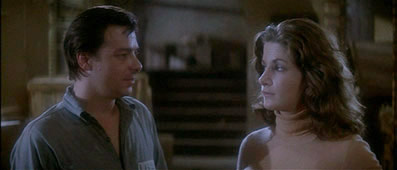
My
first experience of the film was a revelatory one and
countless viewings later I still warm to the humour
and characters and admire the hell out of the way
it tells its story and the sheer skill with which it
is assembled. And all these years and viewings further
down the line only one thing in the whole film continues
to bug me. After Wells has made his attempted departure
through the sewer hatch, Leigh asks Wilson why he didn't
take off down the sewer in the other direction. As a
character moment this works well, as it gives Wilson
the chance to display an inner nobility and let his
developing feelings for Leigh flicker to the surface
(though it is to Carpenter's credit that this is as
near as they come to actually admitting what they feel
for each other), but I remain to this day bothered by
just one thing: the sewer had another
exit? Then why the hell did Wells risk life and
limb crawling out of a manhole and exposing himself
to the wrath of the gang when he could have skipped
unseen in the other direction and emerged from a manhole
cover that did not have fifty guns pointed at it? Ah,
who cares. It was a bloody marvelous film back in the
late 1970s and its still a marvelous film now. Assault
on Precinct 13 manages the rare trick of effectively
borrowing from two classic films without ever feeling like a direct remake, and time has ensured that it has, like its
noble predecessors, achieved classic status of its own.
Surprisingly,
the film failed to make an impression on its initial
American release, but following a triumphant screening
at the London Film Festival (where it received a standing
ovation), it found considerable favour in Europe and
especially the UK, and its success here eventually spread
back to the US. Carpenter had originally attracted the
attention of the Assault investors
through the sale of his script Eyes,
which eventually became The Eyes of Laura Mars,
a film he was originally slated to direct until a falling
out with the producers over key elements of the content.
The story revolved around a female photographer who
begins to experience visions in which she sees through
the eyes of a murderer in the act of killing – Carpenter
believed that the killer should remain an anonymous
threat that would slowly close in on her, but the producers
insisted that he should be someone the woman knew personally,
perhaps even loved, so that there would also be an emotional
battle to fight. Unable to resolve this issues to his
satisfaction, he took the then bold decision (this could
have been his big breakthrough film, after all) and
walked. He was able to realise his vision of a resourcesful
woman stalked by an anonymous killer (and pay homage
to Hitchcock) in his compelling and too-little-seen 1978 TV movie Someone's
Watching Me, but it was his made-for-cinema twist
on the tale made later the same year – a little film called Halloween – that really put him on the map. He followed this with Elvis: The Movie, which on its first
screening became the most watched TV movie of all time.
The rest, as they say, is history.
What
was the first DVD you bought? Seems a long time ago now,
doesn't it? Mine was Image Entertainment's original region
0 DVD of Assault on Precinct 13. At the
time, it was a most exciting purchase – after years of crappy
quality, painfully cropped TV screenings and VHS releases,
here was one of my favourite films back in its original
aspect ratio and looking better than I ever believed it
could on a home video format. Of course, once I had a big
widescreen TV and a few hundred other releases to compare
it to I was more aware of the definition issues of non-anamorphic
NTSC, though given those restrictions I still felt this
was a most reasonable transfer. Last year Image re-released
the film as a special edition with a couple more extras
and an anamorphic transfer, and it made a real difference.
Despite a few noticeable compression artefacts on dimly
lit areas of a similar colour (station walls, in the main)
and a few dust spots, this is a very nice transfer,
with sharpness, contrast and colour all of a high order,
and even the darker scenes in the besieged station clearly
reproduced.
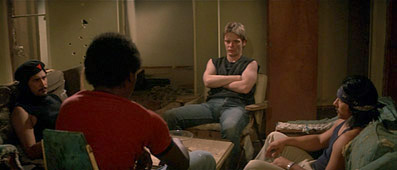
Contender's
region 2 release also replaces an earlier version, this
time from Universal, a travesty of a disc that saw Douglas
Knapp's careful compositions cropped to 1.78:1 and given
only an average transfer even then. Contender's disk certainly
puts things right on the picture front. Like the Image release,
the transfer is very impressive, with detail, colour and
contrast very pleasing, though it shares the occasional
compression artefacts in some scenes (check the walls in
the scene in which we are introduced to Napoleon Wilson
or when Bishop shares a coffee with Leigh). The infrequent
though visible dust spots on the Image disk appear not to
be present here, and the extra resolution offered by PAL
over NTSC does occasionally make itself effectively felt.
In this respect I'd have to say that the Contender disk
has a slight edge.
The
sound is the original mono on both disks, but is very clear
and clean in both instances, the bass notes of Carpenter's
music really coming across well. As someone who knows the
film inside out and has listened to the soundtrack CD a
good few times, the frame-a-second PAL speedup does notice,
and I thus prefer the region 1 disk, which also has an isolated
music track for Carpenter soundtrack fans.
Here
is where the two disks really part company, and where
I have to once again take issue with the utterly misleading
use of the term 'special edition'. The Contender region
2 release does indeed put right a previous wrong in presenting
the film in its original aspect ratio for the first time
on region 2, but given that the vast majority of DVD releases
since the medium first found popularity have the films
in their correct aspect ratio, to give the DVD a 'Special
Widescreen Edition' label is frankly taking the piss,
especially given the almost complete lack of extras on
the disc itself (do not be misled by the current listing
on Amazon, which promises all of the features found on
the Image disk). Indeed, the only worthwhile extra of
note is a booklet detailing
the background to the film, with information on the director
and some of the actors.
On
the disc itself there are only two extra features. Gallery consists of just 10, iffy quality stills and one re-release
poster (which is also in the booklet), all about half
screen size. The Trailer (1:56)
is anamorphic 16:9 and in not bad shape, at least when compared to the one on the Image disc (see below). Some of the
footage is desaturated to the level that it is almost
black and white, but this appears to have been deliberate.
Though
the Image region 1 disk is also a case of upgrading rather
than reinventing, it does at least stand on its own merits
as a Special Edition.
The
key extra, and the best reason for choosing the Image
release over the Contender one, is the Commentary by director John Carpenter, which was on the first release
and ported over from the original laserdisk. A typically
fascinating and informative track, it covers everything
from the influences that shaped specific scenes to the
use of various locations (Bishop's arrival at the station
is particularly illuminating, utilising as it does four
separate locations and a sound stage), the involvement
of crew members and friends in minor roles, and the technical
aspects of shooting and editing, including the fact that
Carpenter's editing duties on two scenes were shared with
art director Tommy Lee Wallace and assistant director
James Nicols. Having had to research for almost six months
and end up with a bibliography that was spread over three
pages for my thesis back in 1980, it was somewhat disconcerting
to hear much of that legwork covered in this one commentary,
but for those who have not read any of the many, many
articles that have been written since on Carpenter and
this film, this is a first rate introduction. The surprising
element is how often Carpenter says he would speed up
the film if he were making it today, something I'm guessing that precious few of
the film's fans would agree with him on, though he does
counter this at one point by admitting that the film actually
benefits from not assaulting the audience with
action.
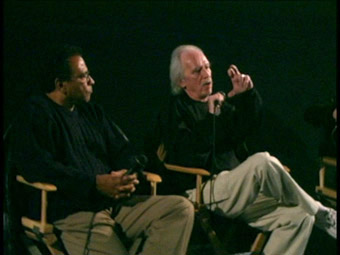
New
to this edition is an Interview with John
Carpenter and Actor Austin Stoker (23:06),
recorded in 2002 at the Egyptian Theatre in Hollywood
as part of a retrospective screening of the director's
works taking place over several days. Shot on DV in one
take and with the sound recorded using the on-camera mic,
resulting in occasional but inevitable clarity issues
with the acoustics of the room, this is nevertheless a
hugely enjoyable inclusion, in the main because Carpenter
himself is so entertaining, taking a light-hearted and
anecdotal approach to the questioning that is constantly
engaging. The audience appears to be made up almost exclusively
of fans of the film and the director, but as someone who
would happily sit amongst them I have no issue with this.
There is also a nice variety to the questions, my favourite
being the man who asks a laughing Carpenter, "How
exactly do you win at potatoes?"
Production
Gallery (16:55) is a substantial rolling collection of behind-the-scenes
stills, extracts from Carpenter's original script and
even some of his delightfully simple storyboards, all
set to music from the film. Framed at very close to 4:3,
the pictures, pleasingly, make full use of that available
screen space.
Isolated
Score does what it says on the tin and good news for those who
do not have the soundtrack on CD (or MP3).
The Theatrical Trailer (2:03) is
the same one as on the original Image release, just blown
up to 16:9 anamorphic, making it virtually identical to
the one on the Contender disk. There is, however, one,
crucial difference: the one here is in a right state,
a blizzard of print damage and flickering that at least
improves as it progresses.
Two Radio Spots (0:32 and 0:33) are exactly
that, but are set to poster artwork from the film, one
per spot.
Assault
on Precinct 13 will always have a special place
in my heart, for its huge entertainment value, for Carpenter's
boldness in making an updated Hawksian western in a time
of forward-looking and often dark sociopolitical thrillers,
for the still shocking shooting that kicks off the main
plot, for its wonderfully sketched characters, for its precision-timed
mix of humour and tension.... I could go on. My relationship
with the film was an intimate one – in a time before the
pause-and-freeze-frame convenience of VHS, I spent many,
many afternoons and evenings in cinemas watching and rewatching
the film, notebook in hand, attempting to memorise every
shot and line of dialogue and note of music for a thesis
that was delivered just three months before Cinefantastique did a Carpenter special that would have effectively rendered
months of research almost invalid. It's thus impossible
for me to be even remotely objective about the film, but
then are we ever about any work of art? I'm not alone here – there are plenty out there for whom Assault on
Precinct 13 is far more than just a well done exploitation
thriller, as evidenced in an article a few years back in,
I believe, the departed Neon magazine, which included
the film in a list of their ten favourite westerns of all
time. Piss on the opportunistically minded remake – the
original is terrific cinema and fabulous entertainment,
and will continue to be held in high regard long after everyone
has forgotten that there even was another version.
If
it's just the film you're interested in then the Contender
region 2 disk will do fine, as despite the lack of extras
the transfer is first rate, showcasing Knapp's photography
to the max and belying the film's low budget origins. But
fans of the film should head straight for Image Entertainment's
region 1 disk – this also sports a fine transfer, but in
addition has an excellent commentary track and the Q&A
with Carpenter and Austin Stoker to recommend it, not to
mention a gallery that completely shames the token inclusion
on the Contender disk.
|